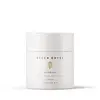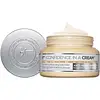What's inside
What's inside
 Key Ingredients
Key Ingredients

 Benefits
Benefits

 Concerns
Concerns

 Ingredients Side-by-side
Ingredients Side-by-side

Camellia Sinensis Leaf Extract
AntimicrobialCamellia Oleifera Seed Oil
Skin ConditioningAloe Barbadensis Leaf Juice
Skin ConditioningSimmondsia Chinensis Seed Oil
EmollientOenothera Biennis Oil
EmollientGlycerin
HumectantPolyacrylate Crosspolymer-6
Emulsion StabilisingGlyceryl Stearate
EmollientCitrus Limon Peel Oil
MaskingPalmitoyl Tripeptide-5
Skin ConditioningPolyglyceryl-6 Palmitate/Succinate
EmulsifyingCetearyl Alcohol
EmollientSqualane
EmollientOpuntia Ficus-Indica Seed Oil
EmollientPlukenetia Volubilis Seed Oil
EmollientSodium Hyaluronate
HumectantLavandula Angustifolia Oil
MaskingCitrus Aurantifolia Oil
CleansingCymbopogon Martini Oil
MaskingTocopherol
AntioxidantCoriandrum Sativum Oil
MaskingUbiquinone
AntioxidantCitrus Limon Fruit Oil
AstringentSodium Bicarbonate
AbrasiveEthyl Ether
SolventEthylhexylglycerin
Skin ConditioningCamellia Sinensis Leaf Extract, Camellia Oleifera Seed Oil, Aloe Barbadensis Leaf Juice, Simmondsia Chinensis Seed Oil, Oenothera Biennis Oil, Glycerin, Polyacrylate Crosspolymer-6, Glyceryl Stearate, Citrus Limon Peel Oil, Palmitoyl Tripeptide-5, Polyglyceryl-6 Palmitate/Succinate, Cetearyl Alcohol, Squalane, Opuntia Ficus-Indica Seed Oil, Plukenetia Volubilis Seed Oil, Sodium Hyaluronate, Lavandula Angustifolia Oil, Citrus Aurantifolia Oil, Cymbopogon Martini Oil, Tocopherol, Coriandrum Sativum Oil, Ubiquinone, Citrus Limon Fruit Oil, Sodium Bicarbonate, Ethyl Ether, Ethylhexylglycerin
Water
Skin ConditioningButylene Glycol
HumectantCyclopentasiloxane
EmollientGlycerin
HumectantButylene Glycol Dicaprylate/Dicaprate
EmollientEthylhexyl Isononanoate
EmollientHydrogenated Polyisobutene
EmollientCaprylic/Capric/Myristic/Stearic Triglyceride
EmollientGlyceryl Stearate
EmollientPEG-100 Stearate
Polyglyceryl-3 Methylglucose Distearate
EmulsifyingStearyl Behenate
EmollientDimethicone
EmollientPentaerythrityl Tetraethylhexanoate
EmollientBiosaccharide Gum-1
HumectantDimethicone/Vinyl Dimethicone Crosspolymer
Skin ConditioningCetearyl Alcohol
EmollientPalmitic Acid
EmollientStearic Acid
CleansingPolyethylene
AbrasivePEG/PPG-20/15 Dimethicone
EmulsifyingPhenyl Methicone
EmollientPortulaca Oleracea Extract
Skin ConditioningCocos Nucifera Oil
MaskingAloe Barbadensis Leaf Extract
EmollientButyrospermum Parkii Butter
Skin ConditioningHydroxyethyl Acrylate/Sodium Acryloyldimethyl Taurate Copolymer
Emulsion StabilisingSodium Hyaluronate
HumectantHydrogenated Lecithin
EmulsifyingPolyquaternium-51
Skin ConditioningNiacinamide
SmoothingHydrolyzed Collagen
EmollientCamellia Sinensis Leaf Extract
AntimicrobialTocopheryl Acetate
AntioxidantCarbomer
Emulsion StabilisingPEG-150 Distearate
EmulsifyingCeramide AP
Skin ConditioningGlycosphingolipids
EmollientGlyceryl Polymethacrylate
Meadowfoam Estolide
Skin ConditioningSorbitan Isostearate
EmulsifyingSqualane
EmollientPalmitoyl Pentapeptide-4
Skin ConditioningPolysorbate 20
EmulsifyingSteareth-20
CleansingN-Hydroxysuccinimide
Skin ConditioningChrysin
Skin ConditioningPalmitoyl Tripeptide-1
Skin ConditioningPalmitoyl Tetrapeptide-7
Skin ConditioningPolysorbate 60
EmulsifyingAleuritic Acid
Skin ConditioningYeast Extract
Skin ConditioningGlycoproteins
Skin ConditioningBetaine
HumectantHydrogenated Polydecene
EmollientCeramide NP
Skin ConditioningAllantoin
Skin ConditioningColloidal Oatmeal
AbsorbentRetinyl Retinoate
Skin ConditioningPolylactic Acid
AbrasiveCanola Oil
EmollientCholesteryl Nonanoate
EmollientAscorbyl Tetraisopalmitate
AntioxidantGlycyrrhiza Glabra Root Extract
BleachingChamomilla Recutita Flower Water
MaskingCurcuma Longa Root Extract
MaskingLeuconostoc/Radish Root Ferment Filtrate
AntimicrobialEruca Sativa Leaf Extract
Skin ConditioningGlyceryl Citrate/Lactate/Linoleate/Oleate
EmulsifyingCeteareth-20
CleansingHydroxypropyl Bispalmitamide Mea
EmollientGlycine Soja Sterols
EmollientMelaleuca Alternifolia Leaf Oil
AntioxidantPhytosteryl/Isostearyl/Cetyl/Stearyl/Behenyl Dimer Dilinoleate
Skin ConditioningSantalum Album Oil
MaskingChamomilla Recutita Flower Oil
MaskingCaprylhydroxamic Acid
Cetearyl Glucoside
EmulsifyingGlucose
HumectantStearyl Stearate
EmollientTromethamine
BufferingCitric Acid
Buffering1,2-Hexanediol
Skin ConditioningChlorhexidine Digluconate
AntimicrobialPotassium Sorbate
PreservativeDipropylene Glycol
HumectantLavandula Angustifolia Oil
MaskingCitrus Paradisi Peel Oil
MaskingCymbopogon Citratus Leaf Oil
MaskingPelargonium Graveolens Oil
MaskingCitrus Aurantium Dulcis Peel Oil
MaskingPogostemon Cablin Leaf Oil
MaskingCitrus Aurantium Bergamia Fruit Oil
MaskingEthylhexylglycerin
Skin ConditioningCaramel
Cosmetic ColorantDisodium EDTA
Phenoxyethanol
PreservativeCaprylyl Glycol
EmollientLimonene
PerfumingLinalool
PerfumingWater, Butylene Glycol, Cyclopentasiloxane, Glycerin, Butylene Glycol Dicaprylate/Dicaprate, Ethylhexyl Isononanoate, Hydrogenated Polyisobutene, Caprylic/Capric/Myristic/Stearic Triglyceride, Glyceryl Stearate, PEG-100 Stearate, Polyglyceryl-3 Methylglucose Distearate, Stearyl Behenate, Dimethicone, Pentaerythrityl Tetraethylhexanoate, Biosaccharide Gum-1, Dimethicone/Vinyl Dimethicone Crosspolymer, Cetearyl Alcohol, Palmitic Acid, Stearic Acid, Polyethylene, PEG/PPG-20/15 Dimethicone, Phenyl Methicone, Portulaca Oleracea Extract, Cocos Nucifera Oil, Aloe Barbadensis Leaf Extract, Butyrospermum Parkii Butter, Hydroxyethyl Acrylate/Sodium Acryloyldimethyl Taurate Copolymer, Sodium Hyaluronate, Hydrogenated Lecithin, Polyquaternium-51, Niacinamide, Hydrolyzed Collagen, Camellia Sinensis Leaf Extract, Tocopheryl Acetate, Carbomer, PEG-150 Distearate, Ceramide AP, Glycosphingolipids, Glyceryl Polymethacrylate, Meadowfoam Estolide, Sorbitan Isostearate, Squalane, Palmitoyl Pentapeptide-4, Polysorbate 20, Steareth-20, N-Hydroxysuccinimide, Chrysin, Palmitoyl Tripeptide-1, Palmitoyl Tetrapeptide-7, Polysorbate 60, Aleuritic Acid, Yeast Extract, Glycoproteins, Betaine, Hydrogenated Polydecene, Ceramide NP, Allantoin, Colloidal Oatmeal, Retinyl Retinoate, Polylactic Acid, Canola Oil, Cholesteryl Nonanoate, Ascorbyl Tetraisopalmitate, Glycyrrhiza Glabra Root Extract, Chamomilla Recutita Flower Water, Curcuma Longa Root Extract, Leuconostoc/Radish Root Ferment Filtrate, Eruca Sativa Leaf Extract, Glyceryl Citrate/Lactate/Linoleate/Oleate, Ceteareth-20, Hydroxypropyl Bispalmitamide Mea, Glycine Soja Sterols, Melaleuca Alternifolia Leaf Oil, Phytosteryl/Isostearyl/Cetyl/Stearyl/Behenyl Dimer Dilinoleate, Santalum Album Oil, Chamomilla Recutita Flower Oil, Caprylhydroxamic Acid, Cetearyl Glucoside, Glucose, Stearyl Stearate, Tromethamine, Citric Acid, 1,2-Hexanediol, Chlorhexidine Digluconate, Potassium Sorbate, Dipropylene Glycol, Lavandula Angustifolia Oil, Citrus Paradisi Peel Oil, Cymbopogon Citratus Leaf Oil, Pelargonium Graveolens Oil, Citrus Aurantium Dulcis Peel Oil, Pogostemon Cablin Leaf Oil, Citrus Aurantium Bergamia Fruit Oil, Ethylhexylglycerin, Caramel, Disodium EDTA, Phenoxyethanol, Caprylyl Glycol, Limonene, Linalool
 Reviews
Reviews

Ingredients Explained
These ingredients are found in both products.
Ingredients higher up in an ingredient list are typically present in a larger amount.
Camellia Sinensis Leaf Extract is derived from the leaves of the tea plant. Black tea, green tea, and oolong tea are all harvested from this plant.
This ingredient has many skin benefits:
This ingredient contains polyphenols, a strong antioxidant. Antioxidants help fight off molecules that damage skin cells.
On top of that, the antioxidants in green tea neutralize free-radicals from the sun. This gives the skin some extra UV protection, but should not replace sunscreen.
Many components of tea have anti-inflammatory properties.
Polyphenols and L-theanine help soothe the skin and reduce irritation. The caffeine in Camellia Sinensis Leaf Extract helps calm inflamed blood vessels.
Other compounds found in tea include: Vitamin Bs, linoleic acid, magnesium, calcium, iron, and zinc.
Research has shown both drinking Camellia Sinensis Leaf Tea and applying it to the skin can help boost skin elasticity and hydration. Studies also show using tea extract may reduce sebum, or oil, production.
Learn more about Camellia Sinensis Leaf ExtractCetearyl alcohol is a mixture of two fatty alcohols: cetyl alcohol and stearyl alcohol. It is mainly used as an emulsifier. Emulsifiers help prevent the separation of oils and products. Due to its composition, it can also be used to thicken a product or help create foam.
Cetearyl alcohol is an emollient. Emollients help soothe and hydrate the skin by trapping moisture.
Studies show Cetearyl alcohol is non-toxic and non-irritating. The FDA allows products labeled "alcohol-free" to have fatty alcohols.
This ingredient is usually derived from plant oils such as palm, vegetable, or coconut oils. There is debate on whether this ingredient will cause acne.
Due to the fatty acid base, this ingredient may not be Malassezia folliculitis safe.
Learn more about Cetearyl AlcoholEthylhexylglycerin (we can't pronounce this either) is commonly used as a preservative and skin softener. It is derived from glyceryl.
You might see Ethylhexylglycerin often paired with other preservatives such as phenoxyethanol. Ethylhexylglycerin has been found to increase the effectiveness of these other preservatives.
Glycerin is already naturally found in your skin. It helps moisturize and protect your skin.
A study from 2016 found glycerin to be more effective as a humectant than AHAs and hyaluronic acid.
As a humectant, it helps the skin stay hydrated by pulling moisture to your skin. The low molecular weight of glycerin allows it to pull moisture into the deeper layers of your skin.
Hydrated skin improves your skin barrier; Your skin barrier helps protect against irritants and bacteria.
Glycerin has also been found to have antimicrobial and antiviral properties. Due to these properties, glycerin is often used in wound and burn treatments.
In cosmetics, glycerin is usually derived from plants such as soybean or palm. However, it can also be sourced from animals, such as tallow or animal fat.
This ingredient is organic, colorless, odorless, and non-toxic.
Glycerin is the name for this ingredient in American English. British English uses Glycerol/Glycerine.
Learn more about GlycerinGlyceryl Stearate is a mix of glycerin and stearic acid.
It is used to stabilize the mixing of water and oil ingredients. By preventing these ingredients from separating, it can help elongate shelf life. It can also help thicken the product's texture.
As an emollient, it helps soften skin and supports barrier-replenishing ingredients.
In cosmetics, Glyceryl Stearate is often made from vegetable oils or synthetically produced.
This ingredient may not be fungal-acne safe
Fun fact: The human body also creates Glyceryl Stearate naturally.
Learn more about Glyceryl StearateLavandula Angustifolia Oil is more commonly known as lavender essential oil. It is considered a fragrancing ingredient.
Lavender imparts a famous scent. While the smell is lovely, this ingredient and may sensitize skin in topical products. This is because about 85% of the oil is made up of linalool and linalyl acetate.
When exposed to air, these two compounds become strong allergens. This ingredient exhibits cytotoxicity at low concentrations; amounts of 0.25% have been shown to damage skin cells.
A study from Japan found this ingredient caused lavender sensitivity after widespread exposure.
Lavender essential oil has some antimicrobial, antibacterial, and anti-inflammatory properties. However, the cons of this ingredient may outweight the pros.
More research is needed to confirm lavender essential oil's effects when used in aromatherapy.
Lavandula Angustifolia is known as the English Lavender and famous for creating purple fields in Provence, France.
Learn more about Lavandula Angustifolia OilSodium Hyaluronate is hyaluronic acid's salt form. It is commonly derived from the sodium salt of hyaluronic acid.
Like hyaluronic acid, it is great at holding water and acts as a humectant. This makes it a great skin hydrating ingredient.
Sodium Hyaluronate is naturally occurring in our bodies and is mostly found in eye fluid and joints.
These are some other common types of Hyaluronic Acid:
Learn more about Sodium HyaluronateSqualane is an emollient that helps the skin hold onto moisture. It's an oily liquid that occurs naturally in certain types of fish and plant oils.
Because squalane boosts hydration in the skin, it also comes with plenty of benefits: it is an antioxidant and can help fight free radicals and skin damage. Squalane is also found to have a detoxifying effect when applied.
Squalane comes from squalene, which occurs naturally within the sebum of our skin. It is one of the oils our skin produces to keep itself hydrated. Squalane is the hydrogenated version of squalene and has a longer shelf life.
Research shows that squalane is non-irritating (even at 100% concentration).
In general, it's a fantastic ingredient. It does a great job at hydrating the skin, and it's suitable for those with sensitive skin.
The source of squalane may impact malassezia / fungal acne. This is because olive oil derived squalane can contain impurities such as fatty acids and plant waxes. Sugarcane derived squalane is recommended for anyone with malassezia concerns.
Is squalane vegan?
This depends on the source. Squalane can be derived from both plants and animals. Most squalane used in skincare comes from plants.
Please note: the source of squalane is only known if disclosed by the brand. We recommend reaching out to the brand if you have any questions about their squalane.
Read more about squalene with an "e".
Is squalane an oil?
Squalane is often called an oil, but it’s technically not; it’s a hydrocarbon, meaning it’s only made of carbon and hydrogen, unlike true oils which are triglycerides made of fatty acids and glycerol.
The term “oil-free” isn’t regulated, so companies can define it however they want. Some exclude all oils, while others just avoid mineral oil or comedogenic oils.
While some people avoid oils thinking they cause breakouts, the right kind of oil (or oil-like ingredient like squalane) can actually help balance and hydrate your skin. It’s worth testing out simple oils or squalane to see what works best for your skin.
Learn more about Squalane